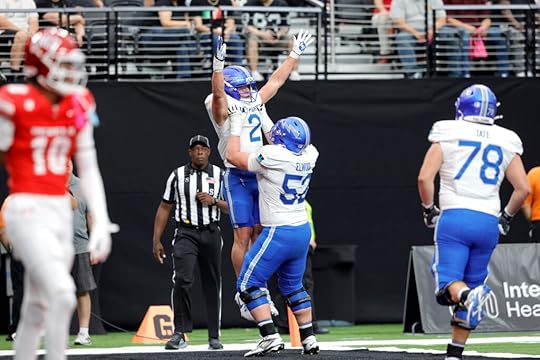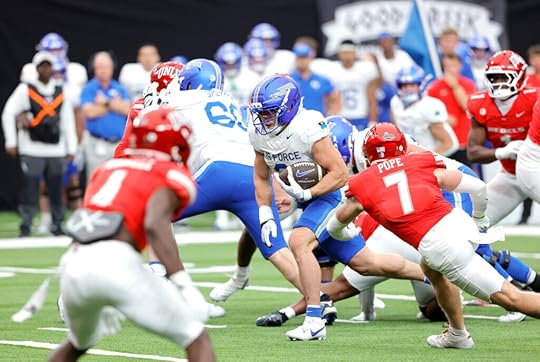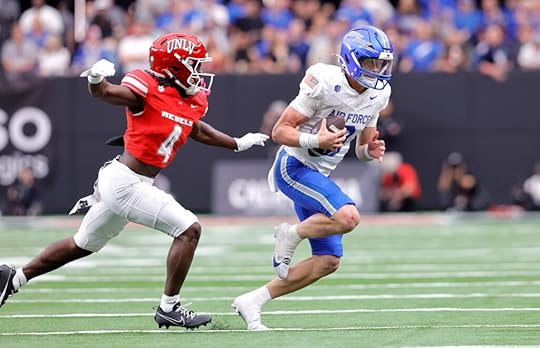Balance from every skill position has been key to Air Force’s explosive offense
LAS VEGAS – At 5-foot-11, UNLV cornerback Mumu Bin-Wahad is not undersized for his position.
There’s a reason West Virginia, UConn and the Rebels, along with Navarro College, have included the well-traveled Atlanta native on their rosters.
But at 6-5, Air Force tight end Bruin Fleischmann towered over Bin-Wahad.
This wouldn’t matter if the Falcons didn’t have the capability to expose that advantage, but that’s precisely what happened on a third-and-3 play from the UNLV 17-yard line in the third quarter on Saturday. Quarterback Liam Szarka threw high and allowed Fleischmann to elevate for the catch, well atop Bin-Wahad, who was in front of Fleischmann and had his right arm extended to defend the pass. Fleishmann caught it at the 3, kept his balance, and a few steps later he was in the end zone and Air Force had retaken the lead.
Of course, the lead went on to change hands seven more times before the Rebels finished off a 51-48 victory in front of 32,932 at Allegiant Stadium.
This play was indicative of so many things for a Falcons’ offense that has moved into the nation’s top 10 in total yards (490.3 per game) and ranks 18th in scoring (38.7 per game).
The throw was in the perfect spot. It went to a tight end. The Falcons were throwing on third and 3. And the touchdown was one of seven scored for the team in the game.
“You look across the depth chart, across the field, we’ve got weapons everywhere – opportunities to make big plays at every position,” said fullback Owen Allen, who ran for a career-high 192 yards and two touchdowns in Saturday’s loss. “When you pair that with those O-linemen and tight ends, you see how they block. … It’s threatening to defenses when you have to worry about that many weapons.”
It’s one thing to have the weapons, it’s another to be able to utilize them the way the Falcons have during this bizarre season.
 Air Force running back Owen Allen (2) celebrates with offensive lineman Nathan Elwood (52) after scoring a touchdown against UNLV during the first half of an NCAA football game Saturday, Oct. 11, 2025, in Las Vegas. (Steve Marcus/Las Vegas Sun via AP)
Air Force running back Owen Allen (2) celebrates with offensive lineman Nathan Elwood (52) after scoring a touchdown against UNLV during the first half of an NCAA football game Saturday, Oct. 11, 2025, in Las Vegas. (Steve Marcus/Las Vegas Sun via AP)Air Force’s yards from scrimmage (rushing and receiving) breaks down like this at the halfway point of the season: Slot receivers 744, quarterbacks 639, fullbacks 580, wide receivers 516, tight ends 244, tailbacks 233.
All six skill positions have accounted for at least 8% of the offense and no position has gained more than 25% of the yards. It’s a balance not seen since at least 2007 for Air Force, which has tended to lean heavily on a particular standout (like fullback Brad Roberts in recent years) and has rarely utilized the tight end (Fleischmann’s 14 catches for 244 yards at the midway point are just two receptions and 16 yards shy of the position’s totals over the past three full seasons).
“I think we have 11 guys who can make plays and we’re kind of highlighting that every single game,” Fleischmann said.
The ability to use each spot has undoubtedly created a multiplier effect for offensive coordinator Mike Thiessen, as defenses are forced to spread their focus in more directions.
Air Force has annually produced a running attack that has finished in the top five of FBS football and used the passing game for rare, but often big, plays as receivers often find themselves open.
Many passing plays this year – including Fleischmann’s catch, several plays from Cade Harris on Saturday and a spectacular 53-yard touchdown from wide receiver Jonah Dawson at Navy, have come in the face of tight defense.
“Their guys made some plays,” UNLV coach Dan Mullen said. “They made some contested catches, and with option teams you’re not used to seeing that.”
The offense has been good enough to keep the Falcons within three points in consecutive road games against unbeaten opponents – Navy and UNLV, both now 6-0 – despite a defense that now ranks last in the nation in yards allowed (496.7 per game) and third from last in points allowed (40 per game).
Where has this balance come from? Outside of Thiessen’s play calling, several variables are at play.
First, there’s an offensive line that returned three starters after outlasting early growing pains in 2024.
“Those stats may be under our name, but it doesn’t happen without them,” said Allen, who scored touchdowns from 28 and 21 yards right up the middle on Saturday without being touched.
 Air Force running back Owen Allen (2) gets past UNLV defensive back Jake Pope (7) and runs for a touchdown during the first half of an NCAA football game Saturday, Oct. 11, 2025, in Las Vegas. (Steve Marcus/Las Vegas Sun via AP)
Air Force running back Owen Allen (2) gets past UNLV defensive back Jake Pope (7) and runs for a touchdown during the first half of an NCAA football game Saturday, Oct. 11, 2025, in Las Vegas. (Steve Marcus/Las Vegas Sun via AP)Also, the nature of a series of shootout games and second-half deficits has demanded the passing game be used more frequently.
Finally, Szarka has burst onto the scene as a sophomore season by orchestrating the offense in a way that has him on pace for numbers – 2,050 passing yards, 1,168 rushing yards if he replicates his production in the second half – that would easily qualify as the best season ever for an Air Force option quarterback.
“He’s a playmaker,” Fleischmann said when addressing his touchdown catch on Saturday. “I would give all the credit to Liam, he threw it in the perfect spot. Defender’s right in front of me and he throws a perfect back-shoulder high point. That’s exactly what any tight end would ask for and I was lucky enough to get a quarterback who could do that.”
 UNLV defensive back Andrew Powdrell (4) prepares to tackle Air Force quarterback Liam Szarka (9) on a quarterback keeper during the first half of an NCAA football game Saturday, Oct. 11, 2025, in Las Vegas. (Steve Marcus/Las Vegas Sun via AP)
UNLV defensive back Andrew Powdrell (4) prepares to tackle Air Force quarterback Liam Szarka (9) on a quarterback keeper during the first half of an NCAA football game Saturday, Oct. 11, 2025, in Las Vegas. (Steve Marcus/Las Vegas Sun via AP)Still, there was no chest-pounding for an offense that has put up big numbers in five consecutive losses.
Asked about any pride taken from putting up 603 yards on Saturday, Fleischmann said the offense should have put up 700 and won.
“Winning’s what matters,” Allen added.
That’s one stat where Air Force (1-5, 0-4 Mountain West), at least when discussing this side of the ball, has yet to find an answer.



